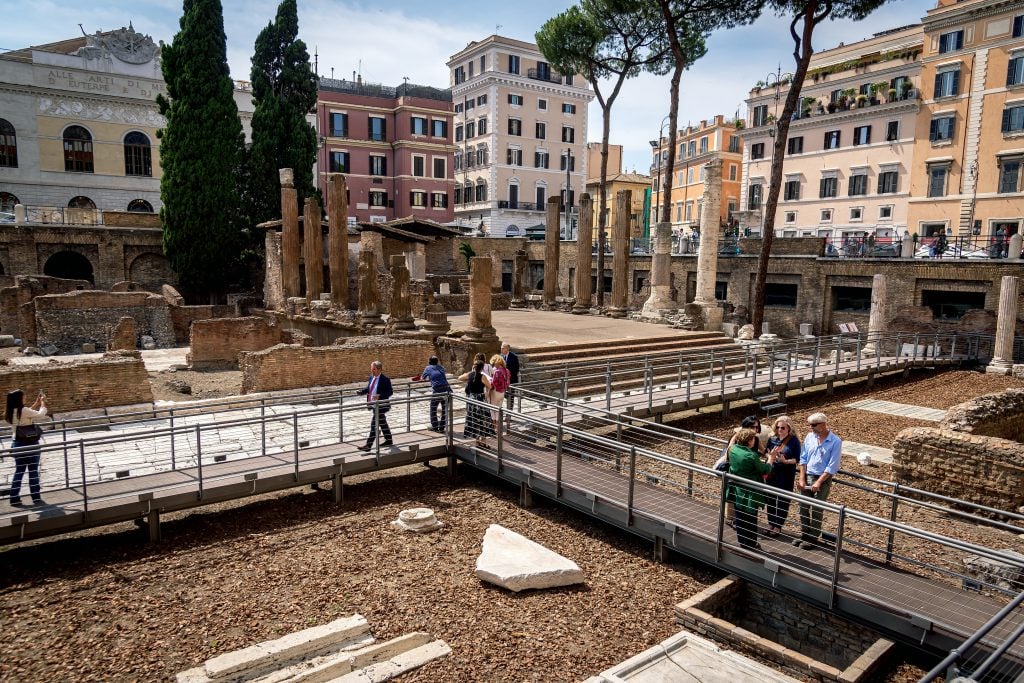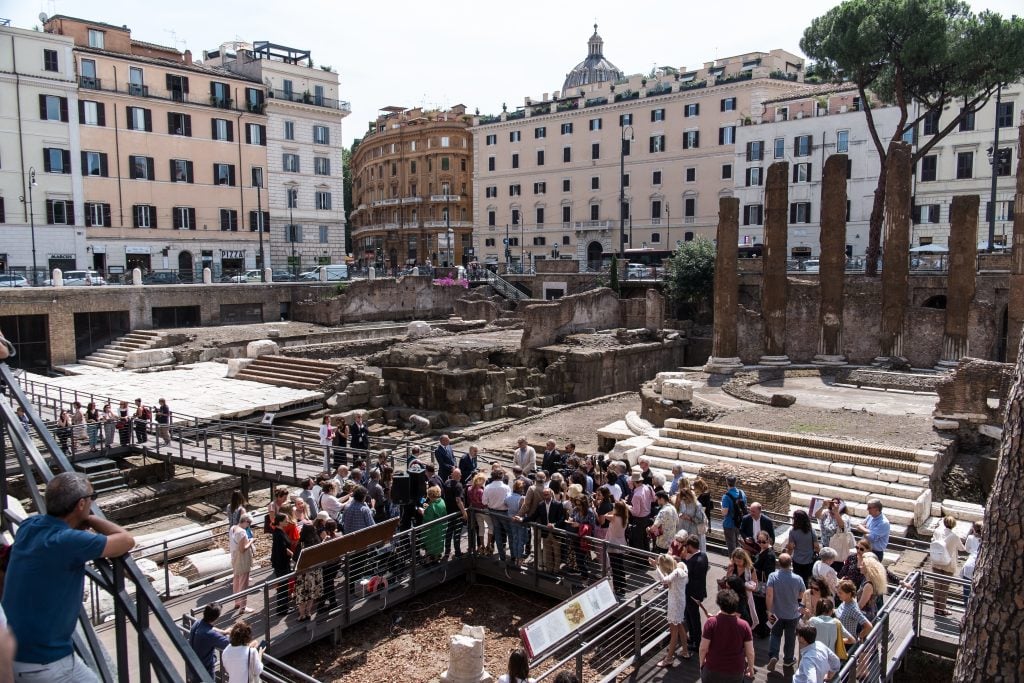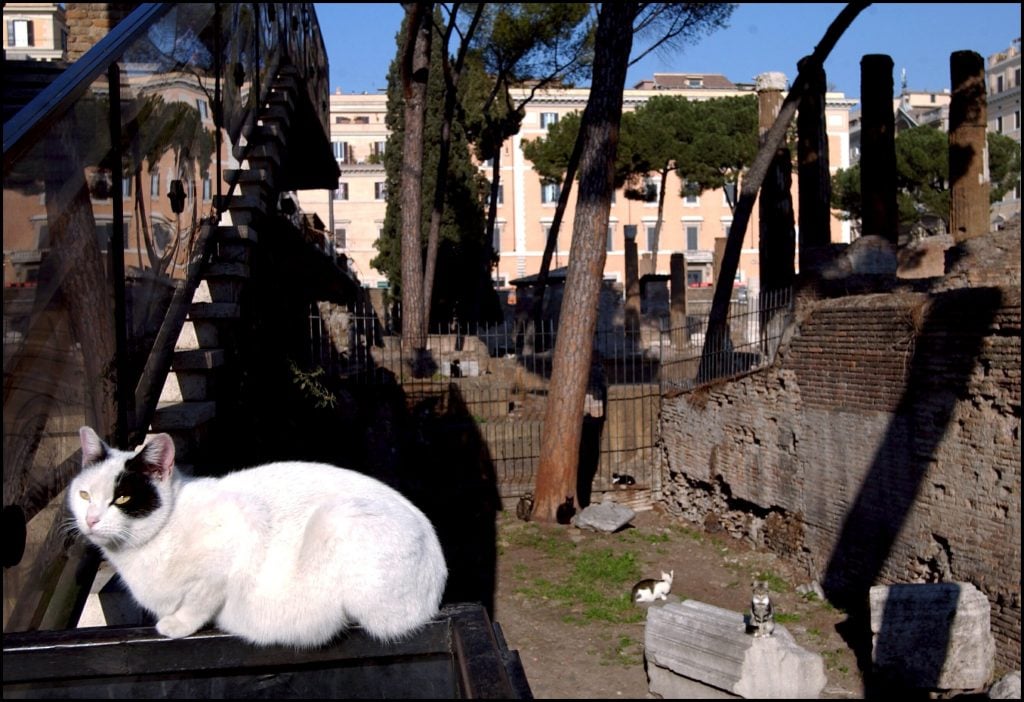One of the most important places in Roman history, the site of the assassination of Julius Caesar, has just been opened to tourists.
Known today as the Sacred Area, or sacred area, the site includes the remains of four ancient Roman temples, as well as what archaeologists have identified as the Curia of Pompey, where Brutus stabbed Caesar on a stone pedestal on the ides of March in the year 44 BC
Italian fashion house Bulgari, which previously financed the restoration of the spanish steps in romehelped pay to build walkways across the site, parts of which date back to the third century BCE. The project was first announced in 2019 and also includes an elevator linking the square below to street level and night lighting of the ruins.
The Area Sacra is located at Largo di Torre Argentinaa square in downtown Rome named after a prominent 15th-century German cardinal from Strasbourg, France, called Argentoratum in Latin – who lived nearby.

The Area Sacra di Largo Argentina in Rome, which includes the Curia of Pompey, site of the assassination of Julius Caesar, is now open to the public for the first time thanks to funding from Bulgari. Photo: Stefano Montesi, Corbis/Corbis via Getty Images.
Since the site was first discovered in the 1920s, amid demolitions ordered by Italian dictator Benito Mussolini, its ancient buildings have only been visible to tourists watching from the sidewalk above. Over the past 2,000 years, the street level has risen thanks to layers of new construction.
Today, the Area Sacra is “one of the best preserved vestiges of the Roman Republic”, archaeologist Claudio Parisi Presicce, superintendent of cultural heritage of the Capitol in Rome, said on Monday during the inauguration ceremony. of the site. Associated press reported.
Archaeologists were able to identify the site of the curia of Pompey thanks to the discovery of the remains of latrines, which correspond to the description of the building in ancient texts, added Parisi Presicce.

The Area Sacra di Largo Argentina in Rome, which includes the Curia of Pompey, site of the assassination of Julius Caesar, is now open to the public for the first time thanks to funding from Bulgari. Photo: Andrea Ronchini/NurPhoto via Getty Images.
There is still some debate about the other buildings on the site, but experts have identified them as the temple of Juturna, the goddess of fountains; the Temple of Fortuna Huiusce Diei, or Fortune today; the Temple of Feronia, a fertility goddess; and the temple of Lares Permarini, believed to be dedicated either to the protectors of navigation or to the nymphs. The Area Sacra also includes travertine paving stones installed by Emperor Domitian after the devastating fire in Rome in 80 AD.
For 30 years, the Area Sacra has also welcomed Torre Argentina Cat Sanctuary, a no-kill shelter that currently houses 86 of the city’s stray cats. It is run by volunteers known as gattare, or “cat ladies”. (Rome officially designated the wildcats in the Forum, Colosseum, and Torre Argentina as part of the city’s “bio-cultural heritage” in 2001.)
The site’s feline residents are sure to be part of the attraction for tourists visiting the site, which costs just €5 ($5.44) to enter.

Cats near the Roman temples of the Sacra di Largo di Torre Argentina area in Rome in 2002. Photo: Eric Vandeville/Gamma-Rapho via Getty Images.
“I came here for the cats,” said a local student named Marielena. Guardian. “We’ve lived nearby for two years and wondered if we’d ever see it finished. The work was very well done, which makes us happy.
Cats and archaeologists have not always had a happy coexistence, and the Ministry of Culture even tried to oust the cat colony a decade ago. Fortunately, relations appear to have improved in recent years, and the cats have been “good workmates” during construction at the site for the past two years, said the site’s chief archaeologist, Monica Ceci. , to the website. New York Times.
As well as spending quality time with the cats, visitors will be able to admire artifacts unearthed during excavations nearly a century ago, including a colossal stone head and a fragment of a winged angel statue from the victoire.
Follow Artnet News on Facebook:
Want to stay one step ahead of the art world? Subscribe to our newsletter to receive breaking news, revealing interviews and incisive reviews that move the conversation forward.
